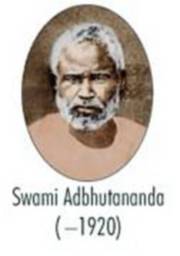All these but confirmed the belief of the temple officials that Sri Ramakrishna must be mad. So they sent a detailed report about these things to Mathur at Calcutta. Soon after this, Mathur paid a surprise visit to the temple, and he was struck with wonder at what he saw. It did not take Mathur long to decide that Sri Ramakrishna’s method of worship was the outcome of a genuine and profound love for the Divine Mother, the like of which is seldom encountered. Convinced that the object of building and maintaining the temple had been attained, he returned to his home and sent an order the next day to the temple Superintendent that the young priest was to have complete freedom to worship in any way he chose, and that he was not to be interfered with.Rani Rasmani was greatly attracted to Sri Ramakrishna, for she felt that his strange behaviour bespoke the fullness of devotion rather than any mental derangement. One day she came to Dakshineswar and after bathing in the Ganga entered the temple to worship and meditate. She later requested Sri Ramakrishna to sing some songs to the Mother. Slowly the music arose from the heart of the devotee; like a fountain of heavenly bliss it bathed his whole being with ecstasy. After a time, the Rani began thinking of some important lawsuit. Noticing her inattentiveness, Sri Ramakrishna gave her a sharp rebuke. At this the Rani’s heart was filled with remorse that worldly thoughts could so influence her mind as to turn it away from the divine bliss which the young priest was lavishly showering on her. Rasmani retired to her room.
Ramakrishna. So he arranged for his treatment by an expert physician, Kaviraj Ganga Prasad Sen of Calcutta. The treatment, though continued for some time, brought no relief. Mathur tried to persuade Sri Ramakrishna to keep his feelings within bounds and to regulate his life in accordance with fixed standards. As Mathur came in closer touch with Sri Ramakrishna and saw more of the Master, he inwardly began to look up to him as a Guru. The relation between the two soon grew to be one of mutual trust and confidence. Sri Ramakrishna would candidly tell of his extraordinary visions to Mathur and also ask his opinion. Mathur, finding in him a happy combination of prophetic wisdom with the innocence of a child, concluded that Sri Ramakrishna’s body was to be his special care, just as in the subtle spiritual domain he himself was protected and guided by the Master. Mathur counted it a rare privilege to be of the least service to the Master, and served him for fourteen years with uncommon zeal and devotion.
another and to follow it with unflinching devotion till that aspect of Truth revealed itself. He now felt a strong urge to realize Sri Rama, who is regarded as an Incarnation of the Lord Himself. He therefore took upon himself the task of reproducing as faithfully as possible the attitude of Hanuman towards Rama – that of the faithful servant towards the master. At the end of this Sadhana (spiritual endeavour) he had a wonderful vision, so exceedingly vivid and so different from any of his previous ones that it remained long in his memory. One day while he was seated in the Panchavati, a luminous female figure of exquisite grace slowly advanced from the north towards him, looking graciously on him all the while. The idea soon flashed within him that she must be Sita whose whole life had been centred in Rama. She suddenly entered into Sri Ramakrishna’s body with the significant remark that she bequeathed the smile on her lips unto him. This was the first vision Sri Ramakrishna had with eyes wide open, without meditating on anything. Ultimately this Sadhana was crowned with the realization of Rama as an Incarnation of God. About this time one evening Sri Ramakrishna felt an irritating sensation in his palate, which after a minute began to bleed. He described the incident as follows: ‘The colour of the blood was dark like the juice of bean leaves. It was so thick that only a little portion fell to the ground and the rest clotted and hung like a string from my teeth. ‘I was sorely perplexed. Fortunately, at that time there was staying in the Kali temple a Sadhu (holy man) who, hearing of the incident, came and examined the colour of the blood and the place from which it came. He said, ‘Thank God! There is no cause for anxiety. This haemorrhage has done you great good. I see you were practising Yoga. This opened your Sushumna canal and a quantity of blood was rushing to the head. It is excellent that this blood, instead of reaching the brain, made a passage through the palate; or you would have entered the Jada Samadhi (the highest form of concentration mentioned in the Yoga-Shastra) from which you could never again have come down to the plane of ordinary consciousness. It must be that the Divine Mother has some great mission to be done through you, and She has saved your body.’ I was reassured by his words and was at peace.’

